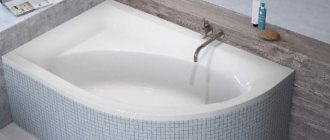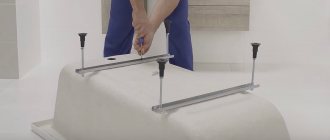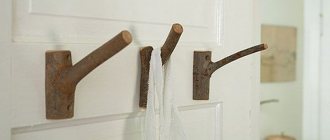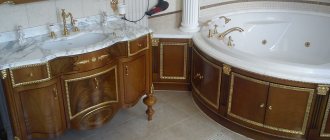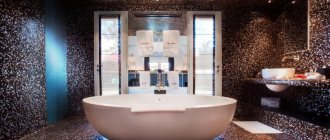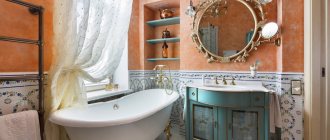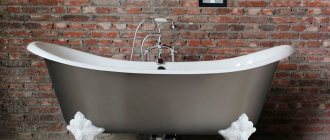In the modern world it is difficult to find a person who has not heard anything about the huge the benefits of hot tubs. Everything would be fine, but these fonts are not cheap. Not everyone can afford such an expensive pleasure.
Or maybe the bathtub has already been installed, repairs have been made, and there is no desire to change the font just for the hydromassage function.
Don’t be upset, you can save a lot by making a jacuzzi with your own hands from an ordinary bathtub. This is not as difficult as it might seem at first glance - details below.
Bath
A bath is a container for washing the body. It comes in different sizes. A small bathtub is called a tub (such as a baby bath or hand bath). When talking about taking a bath, they say: “take a bath.” This is similar to the expression “take medicine”, since there is such a medical purpose. For some diseases, the doctor prescribes certain procedures, including baths. In this case, the meaning of the word changes, and it means the process of finding some part of the body under water or the complete immersion of a person. For example, sea baths are simply swimming in the sea. Foot baths with mustard are an excellent remedy for colds. But it is not necessary for them to fill the entire bath; a basin is enough.
Schoolchildren have a question when making sentences with this word. Children type into the search bar: “Take a bath or bath? Which is correct? In order to use this word correctly, let’s look at changing it by case. In the instrumental it will sound like this: (what?) bathroom. And confusion arises because the bathroom is the room where the bathtub is installed. The word "bathroom" in the genitive, dative, instrumental and prepositional will be "bath", and in the accusative - "bath". For example:
- dissatisfied with the old bathroom, but happy with the bathroom renovation;
- There is no bathroom in the dacha, but there is a bath in the garden.
Chemicals
In order to clean the bathroom at home, you need to use household chemicals that can be purchased in the store. They may not be cheap, and they clearly have no health benefits, but with the right choice of product, you can clean off even old plaque without any problems.
The most famous and well-proven compositions are the following:
- Domestos is an excellent product for everyday care, despite the high chlorine content in its composition. It can easily remove medium-difficult dirt, but deeply ingrained dirt and plaque will pose a serious challenge for it. In addition, this product has a fairly strong smell that not everyone can withstand for a long time.
- Cillit Bang is an indispensable product for regular use, but it is powerless against old rust.
- Cif is a cream or gel substance. The Ultra White series will help remove yellow plaque.
- "Pemolux" - its main component is soda, it has an excellent cleansing effect, and also does not pose a threat to health. It will perfectly help remove dirt from old bathtubs with damaged enamel.
- Comet-gel is suitable for whitening enamel and removing complex stains. The most effective is the “7 days of cleanliness” series, which has a long-lasting effect.
It is noteworthy that each of the listed products has its own unique properties and is suitable for certain types of pollution.
Bathroom
Archaeologists have found bathrooms that are about five thousand years old. In the Middle Ages, it was not customary to take care of your body. But by the mid-nineteenth century, bathrooms again entered the human home. The word "bathroom" is an abbreviation of the phrase "bathroom".
This word is used in the same way as words meaning other rooms. For example:
- We will renovate only the bathroom (library, living room), the rest of the apartment looks good.
- The rural house project does not have a bathroom (dining room, children's room), but there is a sauna.
- The new apartment has a large bathroom, but the bathtub has not been installed yet.
How often do we ask a child: “Have you already gone to the bathroom?”, meaning by this his daily body care. But if you use the concepts of bathtub or bathroom incorrectly, you get a funny situation.
- Going to the bathroom - it’s clear why. Wash in the bathtub standing there; soak, wash and rinse the laundry. If the bathroom is combined, it is also called a bathroom, or bathtub for short.
- A cat can go to the bath, but not a person. A person has a toilet for this.
Floating furniture
Wall-mounted cabinets and sanitary ware with similar mounting will help you completely transform your bathroom. The floors remain completely free, and this leads to two positive consequences. Firstly, cleaning such a bathroom will be much easier , because you won’t have to carefully crawl into the narrow spaces between the legs and the wall. Secondly, visually the room will look more spacious and lighter .
Common Expressions
Bath or bathroom – which is correct? It is enough to remember a few frequently used expressions with these words to figure it out.
- I'll go to the bathroom and come back.
- To take a bath.
- I can't come over, I'm in the bathroom.
- The bathtub is leaking.
- Bathroom renovation.
Depending on what is meant - a room or an object in it, the meaning of the sentence composed with this word changes.
DIY bath (mini-pool/font/bowl)
Friends. I’m starting this topic because there is generally little information on the RuNet. There are only a few practically implemented similar ideas with descriptions.
Backstory: These small bathtubs in bathrooms have always bothered me. I bought an apartment and am doing a complete overhaul. I want to make a mini-pool, or who understands the word “bath” better, from building materials. This is an ordinary bathtub, only slightly larger. Not a pool with constantly filled water and no swimming lanes. It’s just that if you call the topic “bathtub in Khrushchev”, many will think that this is a bathroom to do with your own hands (renovation).
Looking ahead and to avoid a bunch of collisions... In all the topics that I read, techies, without understanding, are yelling that this is dangerous, impossible, atata, bad, etc. Ordinary people, having read enough techies, add their fantasies of the end of the world and also yell that it’s scary live with a bathroom like this. Fear overcomes them so much that even I feel uneasy. No one gives really suitable calculations. I will list their arguments:
_1. the slabs will not hold up and the bathtub will collapse, because the load on the slab is maximum 400 kg._
- Any aquarist knows that normally the plate holds almost a ton per square. Any passerby has seen pallets of bricks and huge baths of mortar on such slabs during the construction of houses. Perhaps people confuse it with wooden floors and give rise to a bunch of rumors. It’s smaller there, and I wouldn’t even undertake to make such a bath for myself.
_2. Even 700 kg per square meter will not withstand a bath!_
- I'm not going to make a font in the literal sense. This is the same bathtub, with the same side (instead of a screen), only of a non-standard shape, and a little deeper. The same laws of physics apply here and with a water height of 50 cm, 500 kg of pressure will be exerted on 1 sq.m of the slab, for example, within an hour. Dangerous? No. These are 5 men who decided to hug, and apparently for the last time)
_3. It is unknown what the floor slabs are made of._
- Of course, both gauna and sticks. Of course, I understand that they built in the Soviet Union terribly; I myself was tormented by leveling the walls in my apartment (load-bearing walls with a brickwork slope of 7cm). But is it permissible to steal cement from a future slab so that its strength drops by as much as half? Well, it had to be completely finished. I don’t even want to think about such phobias. Then bricks would fall on your head every day.
_4. They won’t approve the redevelopment!_
- It doesn't matter. By and large, a homemade bathtub side does not mean that it is a bathtub. When evaluating an apartment, let’s say you can simply put an acrylic bathtub into a homemade one and let them prove otherwise. If there is a complete dead end, then the apartment will be sold only for cash without a bank assessment.
_5. It will flood all 100 floors of the house!_
- Why pour a ton of water at once? You can check the hydraulic strength of the bottom with a smaller volume and wait for greetings from your neighbors. Well, we’ll do it so that 100% of it doesn’t flood, otherwise it’s better not to do it at all.
_6. We need water purification systems and other equipment for swimming pools._
- I don't plan to make a swimming pool in its literal sense. I don't plan to organize swims. The water will not stand for a week. I am making the same corner bath, only with a larger capacity. 3 times. For the kids and for the wife. If you wanted to splash around, you went and poured it in 20-30 minutes.
_7. Still a lot of water consumption!_
- Don't install meters. Either install a magnet, or don’t bother at all. Consumption is only 3 times more than a regular bath. It's worth it.
_8. Cold bottom!_
- You need to do it correctly and insulate the bottom from the slab itself.
_9. Difficulty in accessing the drain and overflow for repairs._
- Here you guys know, I’ve lived in different apartments for 37 years. And I have never had to disassemble a drain with a water seal anywhere except the kitchen. It's clear in the kitchen. And in the bathroom there are crumbs and hair. Everything can be solved with good chemistry and a plunger. Take off the gold, girls, if you are afraid of dropping your earring.
_10. The walls will not withstand the pressure of water and will swell._
- We google graphs of water pressure on walls depending on the height of the water column and don’t worry about it anymore.
_eleven. The water pressure will crack the bottom of the bathtub!_
- A column of water 50 cm high, which presses 1 square. cm of bottom weighs very little. Any bottom will withstand without problems.
_12. There will be constant leaks from thermal expansion of materials and the formation of cracks._
- I have nothing to justify here and we will look for a solution among the pros.
What is given: The house is brick, 12 storeys. Floor 7. The thickness of the load-bearing walls is not less than 0.6 m. Bathroom size 1.6*2.5m. The bathroom is located near the load-bearing wall. That is, the pressure on the slab will not be in the center, but from the edge together with the support on the load-bearing wall. So, the future bathtub will be surrounded by: one load-bearing brick wall, 2 plaster partitions (8cm) and 1 homemade side partition in the center of the bathroom. Concrete floor slabs. The slabs in the house sank normally to 5cm in the center.
The size of the bathtub will be in the form of a trapezoid and will occupy slightly less than half of the bathroom. Roughly speaking, the bottom area (without taking into account the slope of the back) is 1.7 m2. The height of the water level is 40-50 cm. Whatever the area of the bath, at a height of 50 cm its pressure per square meter will be 500 kg of pure water.
Main goals:
- So that the structure is not heavy without taking into account water
- So that the bath does not leak or fall apart.
There are different ways:
- You can weld a caisson from sheets of steel and then finish it.
- Can something similar be made from fiberglass/acrylic (ask boatmen questions)
- You can make it like a real aquarium out of glass (questions for aquarists, but glass will be very expensive)
- It can be made of wood (well, that’s it)
- It can be made from available building materials.
I choose the latter method due to my limited budget. Make it from gaun and sticks, that is, from something that is not expensive and is sold in the store and is used in similar tasks.
What I'm planning:
- (Already done) Build a partition (cement 500 + sand + expanded clay, all 1 to 1 + water repellent for water-repellent properties + 10mm reinforcement with 10cm cage). I crashed the reinforcement into the adjacent walls. The result is a monolithic wall that can withstand lateral water pressure 1000 times. I made it this way only because it would be too thick to build from blocks. And here it’s only 5cm thick and plus the tiles.
- Prime several times with Ceresit 17 primer and waterproof with Ceresit Mastic 51 the screed and 4 walls of the future bathtub, plus tape for the corners.
- The bottom of the bathtub must be higher than the sewer inlet, taking into account the slope. It must be raised at least 10cm. To facilitate the design, so as not to pour a heavy (over 200-300 kg) foundation under the bottom of the bathtub, it was decided to use Penoplex 5cm thick in two layers with glue. They have excellent strength and in addition they are an ideal thermal insulator for the bottom of the bathtub from a large cold stove.
- Cut out a shape in polystyrene foam for installing a drain with a water seal, set the drain to the required level and connect it to the sewer outlet. Calculate the level taking into account the fact that about 3 cm of screed will be poured on top of the penoplex and tiles will also be laid on the screed.
- Install an overflow for drainage in one of the walls.
- Place a 5cm masonry mesh on top of the penoplex on the beacons made of mortar. Make beacons with a slight slope towards the drain.
- Place a foam plug with sealant in the drain neck.
- Pour the same solution (as the partition) onto a 3cm thick screed on top of the penoplex. The drain and water seal will fill tightly. There will be no access to it. Check it for leaks in advance and ask for silicone.
- After the screed has dried and shrinked, seal the contact area between the bottom of the screed and the drain neck in a circle to prevent leakage.
- Waterproof again with Ceresit 51 Mastic on top of the bathtub bottom screed, gluing the corners with waterproofing tape.
- Tile the bottom and walls over the waterproofing.
- Grout the joints with epoxy grout. Apply grout under the decorative drain trim.
This is how I sketched out the tasks purely theoretically. I am interested in the practical application of this or that material in order to really understand how it will behave in the bathroom.
- Suppose the partition and screed still shrink, causing cracks to appear. Before laying the tiles, after waiting for complete drying, you can waterproof them thoroughly.
- Thermal compression/expansion may cause the screed to collapse. I hope that the water will not escape further than the hydrobarriers made of elastic waterproofing Ceresit 51, even if it seeps through the grout somewhere in the tile. Then it will evaporate in the same way. But this mastic cannot be used for “swimming pools”.
- Water should not go beyond the top layer of the tile at all due to the epoxy grout.
If, after all, the specialists convince us not to use building materials, then I’ll weld a caisson or go to the guys who make yachts.
If experts still prove that 400 kg per 1 square is the maximum for a stove, then you will simply have to limit the water level through the overflow to 35-40 cm, as in standard baths.
How to spell: bath or bathroom. Examples
If we are talking about a bathtub that is located in the bathroom, it is not enough to know the definitions of these words. To avoid making a mistake, we try to clarify the proposal. And let's see if the meaning has changed. So, bath or tub? How to write and speak correctly?
1. Since ensuite is a shortened name for bathroom, you can add the word “room”. This will show whether the word "bathroom" should be used:
- In our house, everyone has a bathroom (room).
- The Ivanovs bought a new bathtub.
In the first case, the meaning of what was said has not changed, which means we write “bathroom”. In the second case, we substitute the word “room” - and it turns out that the Ivanovs bought another bathroom. Nonsense. So, we write “bath”.
2. You can call the bathtub a “water tank.” If the meaning does not change, then we write “bath”:
- We placed a cabinet with a first aid kit in the bathroom.
- The Ivanovs bought a new bathtub (water tank).
In the first case, by substituting a synonym, the meaning is lost. And in the second - it is preserved.
Bathroom design photo 2020: modern ideas
What should be included in a “standard set” of a bathroom? Toilet, bathtub, sink and several cabinets/bedside tables to store essentials. Not such a big list that you would have to give up anything. But it is still worth paying close attention to some elements.
How to remember?
There is an easy way to remember how to correctly say: bath or bathroom. The meaning always changes if these words are mixed up:
- I'm taking a bath;
- I am in the bathroom.
In the first case, the person is in a container for ablution. The only reason for this is to use the bathtub for its intended purpose. In the second case, the person is in the bathroom. There are many reasons why he might be doing something there. And ablution is just one of them. He can, for example, sort out the laundry. Or kick the cat out from under the bathtub. Or repair the siphon.
Based on the meaning embedded in the sentence, the situation becomes clear. For example, a clothed person will not take a bath. Of course, there are exceptions, like Hippolyte from the film “Enjoy Your Bath,” who climbed into the shower in his coat. But we are interested in the usual and widespread use of the word. Most likely, we are talking about the person being in the bathroom. To put it briefly - in the bathroom.
Conversely, when they say “he is taking a bath,” they mean a water procedure using plumbing equipment. You can accept the bathroom from the foreman who made repairs in it, and you sign the work acceptance certificate.
If we came to pick up a friend, and she shouts from somewhere deep in the apartment:
- I'm already dressed, I'm putting on my makeup in the bathroom.
Clearly, in the bathroom she uses the mirror over the sink to apply makeup on her eyelashes. And if you change just one word, it looks like she's immersed in a bathtub full of paint. And dressed. It’s time to call the doctors to see if everything is okay with her health.
About grounding spotlights
If you look at almost any modern spotlight, you can see that the manufacturers have equipped it with a grounding terminal. But these lamps are located at a distance from water sources. Why do they need to be grounded? Perhaps this precaution will be unnecessary?
A humid environment is dangerous because electrical charges in it can spread not only along electrical wires, but also along condensation-covered floors, as well as along damp walls and ceilings. They are also well transmitted along load-bearing profile structures that are used when installing suspended ceilings.
If you neglect the grounding of spotlights, then when the phase gets wet, the charge can spread along the profile, and then along the wetted wall. If a person is taking a shower at this moment, he may accidentally lean against the wall or simply touch it with any part of his body. In this case, he will receive an electric shock that will pass through his body and go to the floor.
It is possible that an electric shock will only be felt as a slight tingling sensation, which is not fatal, but still unpleasant. But you can also get a full blow with unpredictable consequences. To prevent this from happening, grounding protection should be used.
Folk remedies to protect cleanliness
However, if you have an individual intolerance or allergy to chemicals, it is quite possible to replace them with folk remedies.
Old dirt, of course, is beyond their power. To scrub a bathtub white requires a lot of physical effort. Nevertheless, these products are preferred by many owners who, for various reasons, do not accept chemistry. Such products do not harm the coating of steel and cast iron bathtubs, and accordingly, their service life is extended. Soda is one of the best folk remedies against various types of pollution, in addition to limescale. Many have already forgotten what a wonderful effect it has, but in vain. It copes well with grease, yellow deposits and unpleasant odors. This is an inexpensive product, moreover, it is harmless. You can simply wipe the surface with it using a regular sponge or use another method.
Baking soda must be mixed in half with baking soda and, after wetting the surface of the bath, apply the resulting mixture for half an hour. After applying this product, wipe the enamel with a sponge soaked in table vinegar. There is no need to wash off the baking soda. After half an hour, the surface must be thoroughly rubbed and then rinsed with warm water.
Table vinegar 9% perfectly removes rust and simple stains. However, the cleaning process itself takes a lot of time. You should moisten paper towels or napkins with vinegar and, using them to cover the entire surface, leave the bath in this state for 3 to 5 hours. After this time, you should rinse the bath thoroughly. It is most likely that thanks to this method the surface will become a couple of tones lighter.
A solution of citric acid will help get rid of limescale and rust. To do this, dissolve 2 tablespoons of acid in 0.5 liters of hot water. Using a sponge, apply it to the surface and wait about 30 minutes, then rinse off.
Mustard powder should be brought to the consistency of a paste, and then rub the problem areas with it.
If you don’t have time for these types of cleaning, then you can use the following recipe. You need to take a full bath of water and pour in 1.5 liters of vinegar or add 100 g of citric acid, leaving this “solution” overnight. In the morning, drain the water and rinse the surface with water.
Examples in various styles
Floating models will become a specific design for almost any style solution.
- Modern.
- Classic.
- High tech.
- Loft.
- Minimalism.
The photo shows a kitchen-living room in a modern style and a soaring plasterboard ceiling with lighting.
The photo shows a single-level soaring ceiling in a high-tech bedroom interior.
Lighting color options
A colored lighting solution will allow you to set a certain mood.
- White.
- Green.
- Neon.
- Red.
- Yellow.
- Blue.
- Violet.
Color spectrum
To create a holistic and stylish apartment interior, you need to correctly use the color palette.
- White.
- Black.
- Beige.
- Brown.
Materials
For different people, certain properties of the bath can be pros and cons. Or they won't matter at all. Therefore, we will simply list the properties of each material, and leave the choice to you
- cast iron. Stood in every bathroom of the Soviet era. The heaviest bathtubs are made of cast iron, so there is an opinion that they are the most stable and reliable. The service life of a high-quality cast iron bathtub is 50 years. But due to the refractoriness of the material, cast iron bathtubs cannot boast of an unusual design. It heats up at an average speed, but does not cool down so quickly. The weak point of cast iron bathtubs is the enamel. True, to damage it, you have to try hard (constantly drop something heavy in the bathroom) or use it for at least five years. Cast iron bathtubs are the heaviest, from 100 kilograms and above. Quite quiet.
- acrylic. It is actively conquering the Russian market with its variety of designs, low cost and ease of installation. The main complaints about acrylic are deflections under heavy weight and unstable construction. To avoid this, choose acrylic from trusted manufacturers, and do not trust products that are too light. When buying an acrylic bathtub, look into the drain hole; the recommended acrylic thickness is 5 mm. For greater reliability, acrylic bathtubs are reinforced with a metal frame. Acrylic bathtubs are quiet, warm and the lightest, 20-25 kilograms.
- steel. Steel bathtubs are the most inexpensive and easiest to use. They heat up quickly and cool down just as quickly. Quite light (30 kg), thin and the noisiest. In terms of variety of shapes and sizes, they are between cast iron and acrylic, but are not in active demand.
Conclusion: to save money we take steel, for convenience and design - high-quality acrylic, for reliability - cast iron.
Design: from classics to art objects
It is advisable to install a free-standing bathtub in bathrooms with a large area. In such a bath you immediately want to lie down for at least an hour, turn off your phone and disconnect.
Most often, the bathroom is built into a podium or placed against a wall, covered with a screen. In this way you can decorate a bathroom of any shape and size.
If you appreciate original design and treat bathing as a ritual, you will love the round bathtub.
It is impossible to take such a bath quickly, if only because it will take a long time to fill. But does this really matter when there is practically a whole swimming pool at home? In one of our projects, we placed a round bathtub at the request of the customer. You can view it here. The height of originality are designer baths worthy of the title of art objects. They are made to order and can be of any shape and from non-standard materials: very durable glass, natural stone or rare wood.
Removing limescale and rust
There is no need to purchase expensive cleaning products, because you can use home remedies, which are often no less effective: they can even remove rust and limescale.
To do this, just use a few useful tips:
- Borax (sodium tetraborate), which can be purchased at a pharmacy, is mixed in half with table vinegar.
- Salt is mixed with heated vinegar until a paste forms.
- Turpentine and salt are mixed in equal proportions.
Any of these mixtures can be applied to the contaminated area and vigorously rubbed with a cloth.
To get rid of rust, you can use several methods:
- Dissolve ammonia in water and treat the stain with this solution, leaving it for 15 minutes, then rinse.
- You can squeeze lemon juice onto the rust and also wait about 15 minutes.
- Wipe the problem area with a mixture of salt and vinegar.
These simple techniques will help get rid of old rust stains and restore the lost whiteness of your bathtub.
What is this?
Tension or hanging fabric with hidden LED strip. With this type of lighting, it seems as if the ceiling structure is floating in the air.
The photo shows a floating ceiling with the lights turned off and on.
